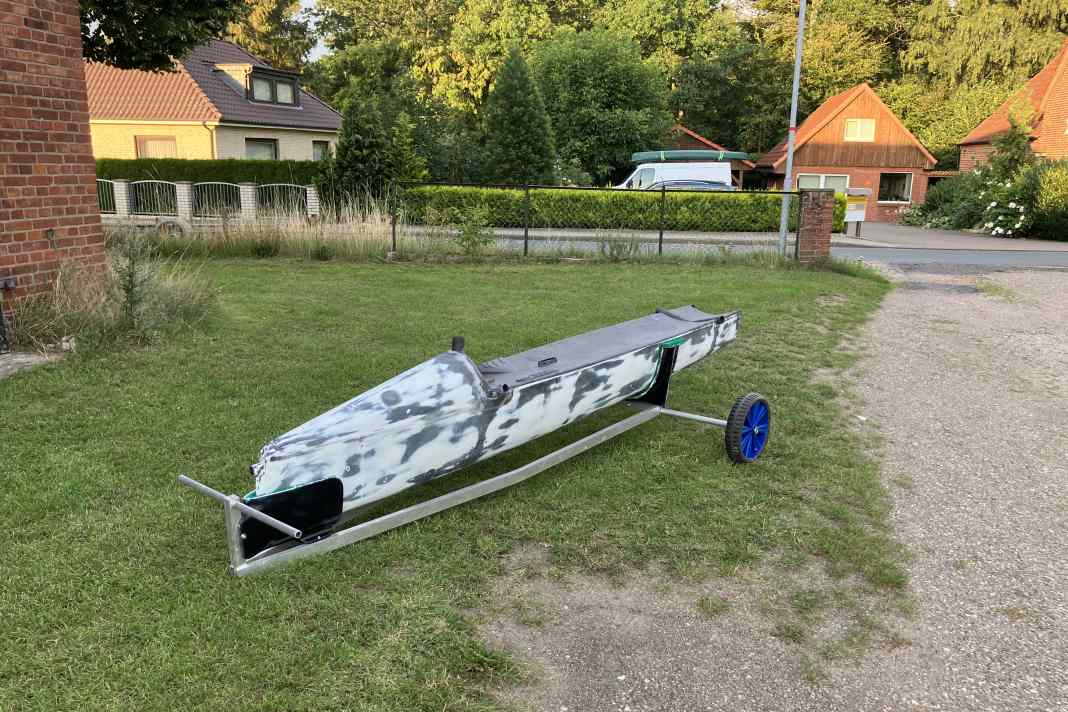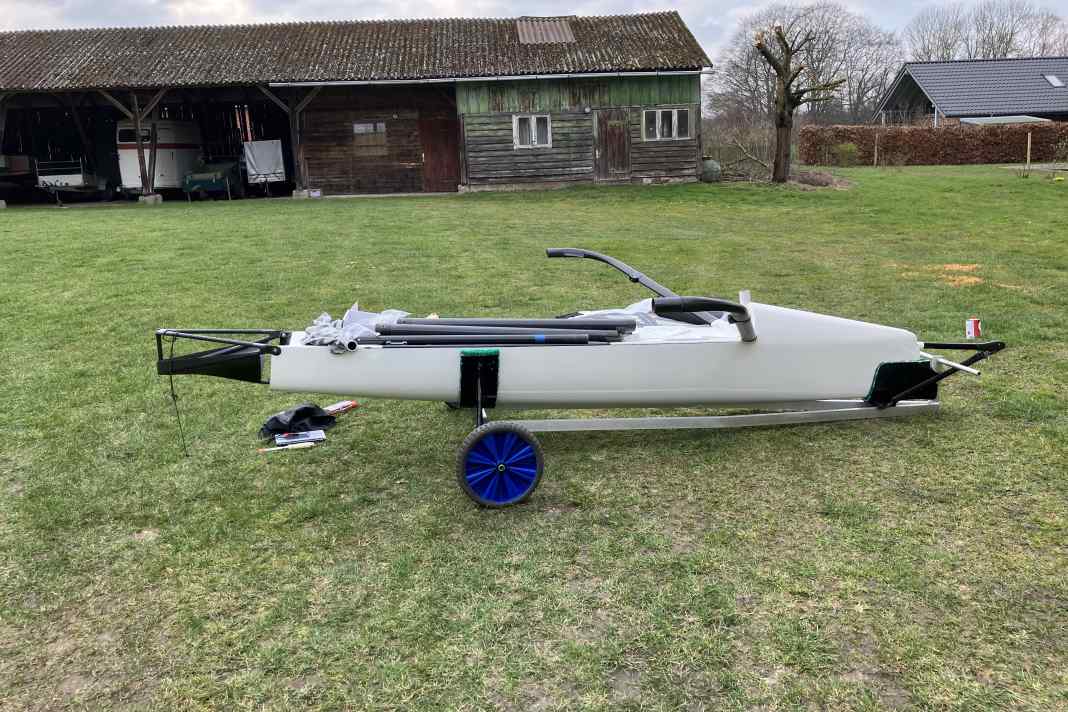





Since its emergence in the 1930s, the Moth class has developed into one of the most spectacular and technologically innovative sailing boats ever. Originally based on the same design rules as the later Olympic Europe, today the Moth is a high-speed racing machine that floats over the water with hydrofoils. At the helm of the nimble butterflies are often not only athletes, but also inventors and visionaries who are constantly pushing the boundaries of physics.
However, it is precisely this enormously rapid technological progress and increasing professionalisation that seems to be putting more and more pressure on the class in other areas. The dinghies, which are only 3.35 metres long, can cost over 45,000 euros when fully equipped these days. Young talent for the class is therefore rare, despite the great fascination of flying and speeds above 30 knots.
"I know a lot of people who would really like the class, but say that the boats are far too expensive," says Merlin Moser, the new President of the German Moth Association (DMV). He has already designed and built three of the filigree butterflies himself. It all started at the end of the current engineer's school days, when the budget for a good boat was still too tight. He had no experience or even training in boat building back then. "I had once been given an old dinghy by my aunt's friend, which I was able to laminate a bit myself," says Moser. His willingness to tinker then continued with two second-hand aircraft until he finally built his own. The 28-year-old is convinced: "Anyone who does anything low-budget in this direction has to do it themselves!"
Many sailors don't have the confidence to do this straight away. However, self-builder Merlin Moser motivates them to do just that: "I think you mainly need a bit of skill and a lot of stamina. The information you need to realise a project like this can be found in books on the Internet. Other DIY enthusiasts also help." And they are usually happy to do so - the class is characterised by a willingness to help. No matter whether it's about knowledge, materials or tools. Regardless of whether they are sailors with Olympic experience or complete beginners.
In any case, it would be really interesting financially if you were to forego a completely new build and refurbish an existing boat instead. This is because the used boat market has a few bargains to offer below the top designs if you look for them carefully and seize the opportunity at the right time.
Moth refit self-experiment: can you be competitive on a low budget?
The raw hull of a Maguire Exocet Motte reaches its destination on Lake Ratzeburg on a sunny Tuesday in June 2023. Without paint and instead in the camouflage look of carbon fibre and filler, the narrow hull looks more like one of the rockets of the same name than a boat. Hull number 4515, presumably built in 2018, had flown through the harbour during a storm in Hong Kong. It was then returned to the manufacturer as an insurance claim, where the boat was refurbished. Shipyard boss Simon Maguire sold the boat to one of the remaining tinkerers. However, he never realised his project and the hull remained untouched in the garage for two years.
Purchasing objects with this kind of history is generally always a bit risky, but it is usually a great opportunity to achieve the desired goal for comparatively favourable money with a little work. The 4515 went over the counter for around 4,500 euros after some minor negotiations. Included in the package: Rig including sails, two bowsprits, an unfinished rudder suspension (gantry) and slip carriage. Even if most of the additional parts turn out to be less than ideal later on, they can easily be resold individually.
During the rest of the shopping tour on the used boat market, it also proved extremely useful to put together whole packages. Sellers are often willing to grant significant discounts in order to get rid of the parts easily, and shipping costs are usually saved. A little later, the main and rudder foils as well as a bent boom and a gantry from Austria were on their way: 2,600 euros. By comparison, a single foil from certain manufacturers can cost up to 4,000 euros even when used.
Bargain hunting for high-tech parts
In order to complete the main components of a moth, we finally went in search of the matching wingbars, the outriggers on which you sit and ride, as well as the corresponding trampolines. Easier said than done, because the construction used on the 4515 was only produced for a short time, and the parts on the market are correspondingly rare. However, at least the linkage could be purchased from an experienced German Moth sailor. However, the price was only really unbeatable at 400 euros when shipyard boss Simon Maguire sent trampolines from England free of charge when he heard about the project.
Simply buying parts and sticking them together does not usually work with moths. The components always have to be re-fitted, reinforced or slightly modified. Sometimes due to inaccuracies, model evolutions or as a precautionary or optimisation measure. However, few sailors can afford to hand over all the work to professionals. You can and must carry out some of the more extensive work yourself so as not to exceed the budget.






Kiel boatyard supports moth refit
This was also the case with the work on the 4515, which was later to be christened the "Schnegge". In addition to the large-scale reinforcement of the fuselage at the base of the rear outriggers, a part for flight altitude control had to be heavily modified, among other things. In this case, the new construction of this part would probably have been of a similar scale. More detailed information on the construction steps can be found in the photo galleries in this article.
In addition to other more experienced moth sailors and self-builders, the young Kiel boatbuilding company Bottsand boatbuilding an important pillar of the project. For a fortnight, it was possible to work on the hull in an almost perfect workshop environment with the help of professionals. Previously, a winter storage hall that was not supplied with electricity and heat had to be used as a workshop, so laminating work had to be carried out elsewhere during the winter. Painting would simply not have been possible.
The situation is different in a heated and, in this case, professionally equipped building. You should also be aware of this before embarking on such projects. The work in the painting tent set up in the shipyard hall put an end to the barren appearance of the refit moth and gave it a new shine. To do this, the hull first had to be levelled and sanded. The general aim is to create the smoothest possible surface with the lowest possible weight.
Paintwork gives Motte a new shine






Two layers of International's epoxy-polyamide primer Interprotect were then applied with a roller. As this work step was also aimed at ensuring a smooth surface, a large part of this primer was then removed again. The fuselage was then prepared for the next coat of paint by filling smaller areas and pinholes again.
This meant that a gun was needed for the first time to apply Awlgrips Quick Build, a high-performance yacht primer system according to the manufacturer. To make it easier to apply the finish, both coats were sprayed in a grey tone, which contrasts with the white final coat.
Once again, intensive but careful sanding was required to keep the weight low and the surface optimised. In the end, it was possible to finish. Nothing less than Awlgrip HDT (High Definition Technology) was used to make the surface of the refit moth shine. The high-end product also impresses with its enormous hardness and scratch resistance and comparatively good repairability.
Conclusion: Was the low-budget project worth it?
After a mere two weeks in the shipyard, the aircraft now "only" had to be put together. Not only was this easier said than done due to some minor details, but there was also no getting round some new parts in advance. Both the blocks and special parts from boat manufacturer Maguire and the ropes were ordered fresh. This is a cost factor that should not be underestimated, as the loads on the mostly very small parts are enormous. And here, too, there are numerous labour hours that are often underestimated at the beginning. Long delivery times, for example from the UK, also make the work more difficult until the sail and foils can be trimmed to meet the requirements.






But then the big day finally came and, completely detached, the elegant moth lifted itself out of the water and into the air, its natural habitat, just a few metres behind the harbour exit. However, it was only in the weeks and months that followed that the refit moth continuously developed its full potential, as it can be optimised much better with the knowledge gained from the water.
The bottom line is around 11,000 euros and 400-500 hours of work for a moth that would currently be traded for just under 15,000 euros on the second-hand market. Because in moderation, the Exocet design, which originally dates back to 2013, is still competitive. Laser world champion and enthusiastic Moth sailor Philipp Buhl recently proved this by winning one of the biggest German Moth regattas with a very similar boat. Below the elite of SailGP, America's Cup and other top sailors, their own boat handling in the demanding manoeuvres is the first priority anyway in order to get around the course quickly. This should motivate all junior sailors with an interest in foiling to perhaps decide in favour of the demanding construction class after all.

